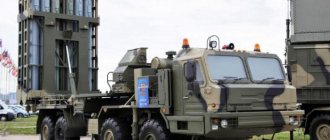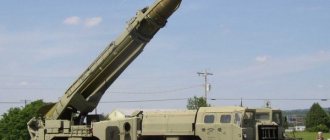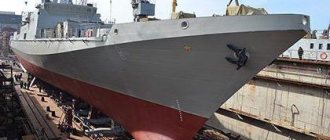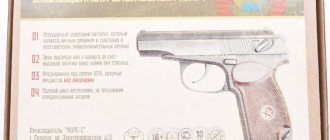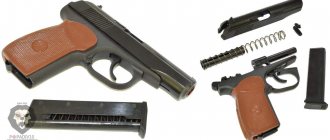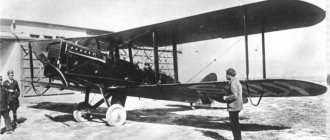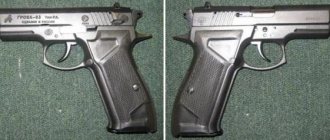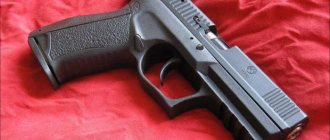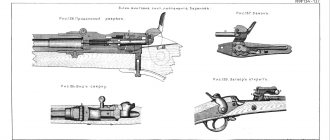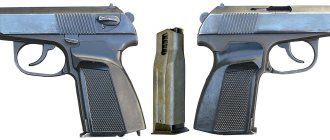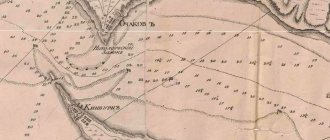Hello weapons
Nikolai Fedorovich Makarov, Hero of Socialist Labor, laureate of the USSR State Prizes and the Prize named after. I.S. Mosin, awarded two Orders of Lenin, the Order of the Red Banner of Labor and many medals.
Nikolai Makarov was born on May 9, 1914. For his father, Fyodor Vasilyevich, the small salary of a locomotive driver did not allow him to feed a large family, in which Nikolai was the fourth child (the Makarovs had six children in total). It was decided to give Kolya to his grandfather to raise him. The boy spent his childhood in the village. He returned to his parents only in 1927 to continue his studies at the seven-year school.
Since childhood, the boy was drawn to metals. One day he and his brother Sasha found an old, burnt American pistol. The guys began its “restoration” secretly from their parents. When all the missing parts were made, the young “gunsmiths” decided to test their homemade product: they poured gunpowder into it, inserted a bullet and went into the yard to the restroom, which was supposed to be a target.
Nikolai took aim and fired! And then... the door swung open, and my father ran out screaming! It turned out that the unsuspecting shooters almost hit their parent - the bullet pierced the plank door and flew over the head of the elder Makarov. He did not flog his sons for their mischief then.
But their “gun” was thrown into the river. However, the son did not grieve for long; a little later, the big-headed Kolka made a double-barreled gun with his own hands.
Later, while studying at the Ryazan Railway School, he made two rationalization proposals, for which he received a reward on behalf of the People's Commissariat of Railways. At home they decided that Nikolai could use the money at his own discretion. The young man surprised his parents by buying a small-caliber rifle. Apparently, even then his soul was drawn to weapons.
At the age of 22, Makarov passed the exams for the workers' faculty course as an external student and submitted an application to the Moscow Higher Technical School. N.E. Bauman. But one point was not enough for admission, and he was sent to study at the Tula Mechanical Institute, one of the main higher educational institutions in the country, training young specialists for the defense industry. Here Makarov mastered the specialty of a gunsmith, which was no longer new to him.
From Alexander II to Leonid Brezhnev
Vladimir Fedorov was among the lucky few, former tsarist officers, who were not affected by the purges of the 30s. We often think about 1937, but there was also 1931, there was the Chekist operation “Spring”, when thousands of former officers were imprisoned or flown out of the Red Army. Konstantin Simonov recalled how it was: his stepfather, a tsarist lieutenant colonel, a Soviet brigade commander, was interrogated for a long time, they were not allowed to sleep, they shined a light in his eyes... But, fortunately, he was not imprisoned. However, he said goodbye to the army forever. (And his bosses, those who renounced him, were repressed in 1937).
For the Bolsheviks, the civil war was won by former tsarist officers: there were about the same number of them on the red side as on the white side. Many were driven into the Red Army by mobilizations, but Fedorov went to serve the new government of his own free will. He wanted to make weapons; his ideas were not in great demand in Imperial Russia. The Red Army appreciated them: they fired from his machine guns in Karelia and the Caucasus during the Civil War, and later on the Basmachi. They managed to fight in both the Finnish and Great Patriotic Wars.
The fact that in Imperial Russia Fedorov’s automatic rifle was met without enthusiasm (after listening to his lecture at the artillery school, Nicholas II said that we did not have enough cartridges for the machine gun) is not surprising. Before the First World War, generals were prejudiced against automatic weapons, but in Russia this was facilitated by the belief in the bayonet, which led to great troubles even during the Russo-Japanese War. The First World War changed everything - a workshop for the production of Fedorov machine guns began to be built at the Sestroretsk arms plant, and later they began to be made at the Kovrov plant. During the USSR, Fedorov worked there as a chief engineer as a civilian specialist. His assistant and student since pre-revolutionary times was the wonderful Soviet gunsmith Vasily Degtyarev, Shpagin and Simonov collaborated with him.
In Soviet times, many natural talents were discovered, they were given a boost - formal education now did not play a big role, and good origin was rather a hindrance (Degtyarev, for example, graduated from three classes of a parochial school). Degtyarev and Fedorov became Doctors of Technical Sciences almost simultaneously, based on a combination of inventions, and it is difficult to get rid of the feeling that the venerable student, beloved by Stalin, served as protection for the teacher.
In 1930, the “Industrial Party” trial, falsified by the Cheka, took place. This was a symbolic blow to the old Russian intelligentsia and personnel specialists. Fedorov was not affected by the repressions, but he had to withdraw from practical activities and left Kovrov. He lived inconspicuously in Moscow, advised the People's Commissariat of Armaments, and wrote a lot on military history.
They remembered him during the Great Patriotic War, when the Soviet government needed to rely on the past. In addition, Fedorov’s inventions perfectly confirmed the idea of the primacy of domestic science. The civilian specialist again became a military man, the tsarist major general became a Soviet lieutenant general. But the military authorities continued to ignore Fedorov’s ideas, just as they had done before the war.
Vladimir Fedorov was born under Alexander II, during the reigns of Alexander III and Nicholas II, and he died when Brezhnev ruled the USSR, in 1966, at 92 years old. Fedorov's works on the history of firearms and bladed weapons still remain among the best.
Makarov and Shpagin
The beginning of the Great Patriotic War found student Makarov in pre-graduation practice. Like others, he was sent as a shift foreman to the People’s Commissariat of Arms plant in the city of Zagorsk, where already in the terrible summer of forty-first the production of Shpagin submachine guns was mastered.
One day Makarov looked into Shpagin’s workshop, where he was designing a more advanced model of his PPSh. Georgy Semenovich squatted in front of a heap of various springs and carefully sorted them out, carefully measuring their thickness, carefully squeezing and stretching them.
Interested in the unusual picture, Nikolai asked the designer about the purpose of his research. Shpagin answered in Volga style:
– I select a spring that would suit my system in all its characteristics.
- So why measure them all, look for them at random? – Makarov asked somewhat surprised. – After all, calculating it is much simpler, faster and more reliable!
“You’re too clever,” Georgy Semenovich looked at Makarov with a smile. – I know that everything can be calculated, but I can’t. Could you?
“Give us the technical conditions,” Nikolai answered confidently, “I’ll do it!”
Two days later, the spring made according to his calculations met absolutely all the specified requirements. Soon Nikolai Makarov became the leading designer for the production of machine guns. But only in 1943, when the opportunity arose, was his diploma project defended as “excellent”.
The main thing of his life
After the war, certified weapons designer Nikolai Makarov returned to Tula to work at the TsKB-14 design bureau. At this time, gunsmith designers, among other tasks, faced the problem of improving short-barreled weapons.
Large Makarov family
Work on the creation of a new self-loading pistol became the main focus for Makarov for the next 5 years. This is how Nikolai Fedorovich himself later recalled: “After the war, a competition was announced to create a new pistol. The designers were informed of the tactical and technical requirements that it had to meet.
I decided to participate in the creation of a new melee weapon. The task was not an easy one. He came to the design bureau at eight in the morning and left at one, or even two in the morning. He developed and tested, or, as the designers say, shot many samples, each time revealing certain shortcomings.
Factory experience told me: a new pistol, like any other mass-produced weapon, must be technologically advanced, that is, easy to manufacture. Ultimately, the pistol turned out to be lighter and more compact than the previous TT. Many famous gunsmiths took part in the competition. The conditions are the toughest. The pistols were dusted with sand, bathed in swamp water, then thickly lubricated, then washed clean in gasoline. The temperature difference is up to 100 degrees: from minus 40 to plus 60. The weapon had to withstand 3,000 shots.”
On the part of yesterday's university graduate, participation in the competition was great arrogance - eminent designers N. Tokarev, S. Simonov, S. Korovin, P. Voevodin . But the tests at the test site ended in a sensation: an unknown young specialist from Tula TsKB-14 became the winner! To create a pistol, he only needed 33 parts, while his closest competitor needed 40. Reliability tests were decisive: after the pistols were dipped in sandy slurry, only the PM “gave a voice.”
It was officially adopted into service in 1951. During this time, more than five million copies were released in our country and about the same number abroad. Makarov's talent gave the pistol a truly long life, ahead of his own.
Where your working youth began...
The Makarovs.
Nadezhda Yakovlevna currently lives in Tula with her son Nikolai Nikolaevich. It is always interesting to walk through the former locomotive depot and see where young Nikolai Makarov began his working life. Here and now, work is in full swing in the carriage repair depot, which is headed by Andrei Alekseevich Gorun .
“We ourselves are not local, we came from Chelyabinsk,” he says with a smile. – But now, having lived here for several years, I consider Sasovo my second hometown. By the way, almost on my first visit to the depot I learned that Makarov, the inventor of the "peam", worked here. I know that his father and other relatives worked here. In 2008, “filmmakers” shot a documentary about Makarov. Now I always show this film when they come to us from other depots.
You could say this is a reason for pride for me: thanks to Makarov, the whole country knows the Sasovo depot. By the way, we also try to be on top in everything, to “keep up the brand.” I read a lot about Makarov. I remember this fact. During his work on the aircraft cannon, Nikolai Fedorovich received... 44 reprimands!
And all because he took the blame of his subordinates upon himself. If the turners missed and ruined parts, they went to Makarov: “Nikolai Fedorych, what should we do?” He answered: “Okay, go.” And his salary was deducted or he was reprimanded. When his colleagues asked him: “Why are you taking it all upon yourself?”, he said: “They still can’t fire me: they need a gun.” This was the kind of character the man had.
Nikolai Fedorovich has traveled a long and glorious path. He gave all his energy, all his talent to the Fatherland, his favorite business. But while doing hard work, Makarov did not forget about his family, friends, and places he loved from childhood. Every year he came with his family to Sasovo on vacation.
After staying with his brother Alexander for a couple of days, he took a tent and went to the meadows, to the banks of the Moksha, where he spent the rest of his vacation. But that is another story.
Gennady Manukhin
Gennady Manukhin: “For many years my personal weapon was the Makarov pistol (PM). More than once, while serving in the army, I took part in the firing of anti-tank guided missiles (ATGM) and, only after returning home after service, I learned that the inventor of this weapon, Nikolai Fedorovich Makarov, was from Sasov. Here, on Lesozavodskaya Street, stands the Makarovs’ house.”
In preparing the article, materials from the research work of Olga Kuznetsova and Vasily Skryner, Tula State Weapons Museum were used.
Photos from the Makarov family archive.
Personal life
The designer’s wife was Nadezhda Yakovlevna, with whom he was married for 44 happy years. Contemporaries spoke of him as a generous, open and simple person who could not stand hypocrisy.
When Makarov received the reward for the Stalin Prize in the amount of 50,000 rubles, he spent it on expensive gifts for relatives, such as a TV, a motorcycle, cameras and other things. At work, he often took the blame when his students made mistakes.
Makarov with his wife
As a result, Nikolai Fedorovich repeatedly received reprimands and lost part of his wages. He explained such actions as follows: “They still won’t fire me - they need weapons.” An interesting fact is that after his retirement, at the request of his wife, he invented a device for rolling canned food.
Makarov pistol (PM)
Makarov Nikolai Fedorovich (born May 9, 1914 in the city of Sasovo, Ryazan region, died May 14, 1988), designer of small arms and aviation weapons, Hero of Socialist Labor (1974).
In 1931–1935 mechanic for repairing steam locomotives at the Sasovo steam locomotive repair depot.
In 1935 he entered the workers' faculty (Moscow), a year later he passed his final exams as an external student and entered the Tula Mechanical Institute.
In 1941, at the beginning of the Great Patriotic War, he was recalled from pre-graduation practice. Without defending his thesis project, he was awarded the qualification of an engineer ahead of schedule and sent to a military plant in the city of Zagorsk, which was subsequently evacuated to the city of Vyatskie Polyany, Kirov Region.
In 1944, he defended his diploma project with honors at the Tula Mechanical Institute and was sent as a leading design engineer to the Research Institute of SPVA (Kuntsevo). Since 1945, chief designer in the direction of the instrument engineering design bureau.
He developed and adopted the 9-mm PM pistol, the AM-23 aircraft cannon and a number of other types of aircraft weapons. With his active participation, based on the latest advances in science and technology, highly effective anti-tank missile systems “Fagot” and “Konkurs” were developed, put into serial production and put into service.
State Prize of the USSR (1952, 1967) and the Prize named after. S.I. Mosin (1963).
Awarded two Orders of Lenin (1971, 1974), the Red Banner of Labor (1966) and medals.
In 1945, a competition was announced in the USSR to develop a new army pistol.
Such luminaries as F.V. took part in the competition. Tokarev, S.G. Simonov, S.A. Korovin, P.V. Voevodin, I.I. Rakov. The young designer of the Tula TsKB-14, Nikolai Fedorovich Makarov, also presented his samples. In October 1945, tests were carried out on prototypes, as well as TT, Beretta 1943, Valther PP, Mauser HSC, Browning 1922, Sauer 38H pistols. Based on the results of these tests, the caliber of the new pistol was determined - it was supposed to be 9 mm, and after repeated tests of the modified samples, the pistol developed by N.F. was recognized as the best. Makarov. In 1951, it was put into service under the name “9-mm Makarov pistol (PM).” Serial production of the Makarov pistol took place at the Izhevsk Mechanical Plant, the same place where the TT pistol was manufactured.
The new pistol used an automatic circuit with inertial locking; it had a so-called “free shutter” that was not connected tightly with the barrel at the moment of firing. Another fundamental difference from the TT was the double-action trigger mechanism, which provided the ability to fire in two modes - with a pre-cocked hammer and self-cocking, which ensures increased combat readiness of the weapon.
Main characteristics: cartridge type – 9x18 mm, magazine capacity – 8 rounds, length – 160 mm, weight without cartridges – 0.73 kg.
Today we can state that as a result of what N.F. Makarov's work created one of the best examples of personal weapons of the 20th century.
For more than five decades, the PM has been in service with the Soviet and now the Russian Army, it is or was in service in more than a dozen countries around the world (excluding states that were formerly part of the USSR), and the service of the Makarov pistol continues.
"I want to live"
Makarov was remembered by his colleagues as an absolute workaholic - he left for work no later than 7 am and rarely returned before midnight. At the same time, he was indifferent to career growth. To climb the career ladder, membership in the CPSU was required, and for some reason Makarov avoided it in every possible way. At the same time, Nikolai Fedorovich also did not have the slightest opposition views.
Another paradox: with all his obvious love for his business, Makarov retired at the first opportunity - when he turned 60. In 1974 he told his wife: “I’d better leave, Nadya. I want to live!” Refused a sinecure position as a consultant at KBP: leave just like that.
Makarov always had a weak heart. But even when he was in a hospital bed, he did not stop inventing something new. His wife recalled how Makarov often became indignant when looking at medical equipment: “Is there really no one who could competently design these devices!” And right in the ward he began to draw sketches of more advanced devices. But the seventh heart attack finished off the gunsmith.
He died on May 14, 1988 at the age of 75. His latest invention was a machine for rolling canned food.
